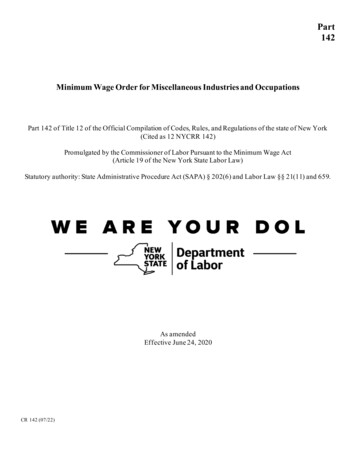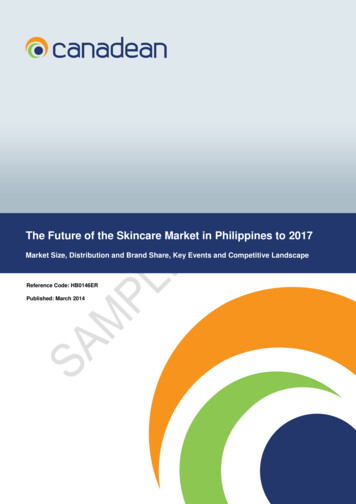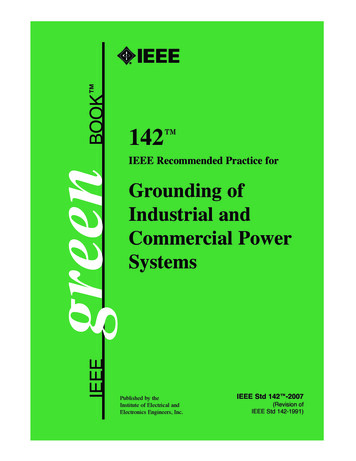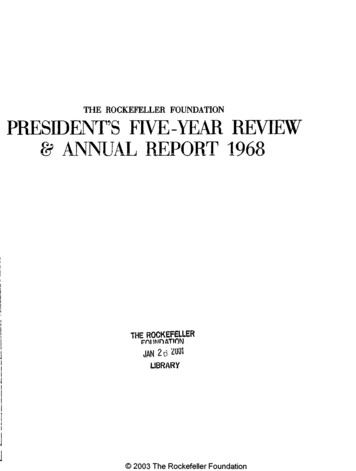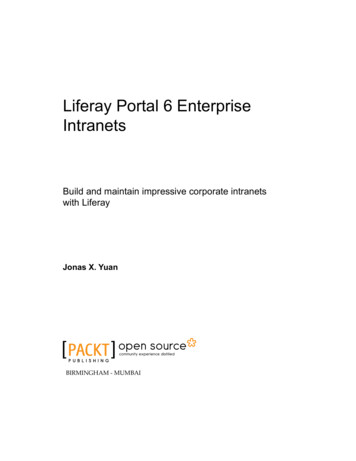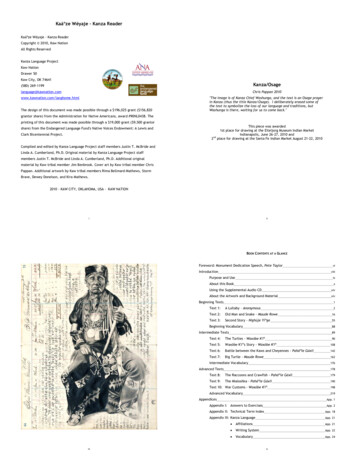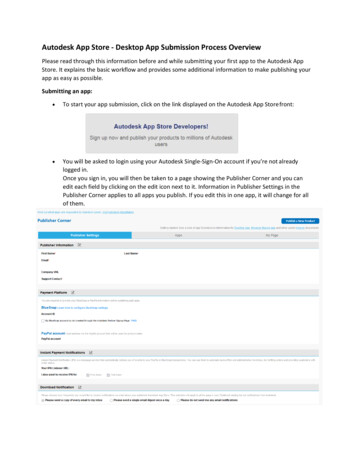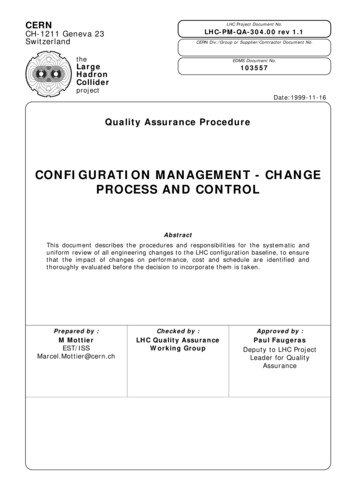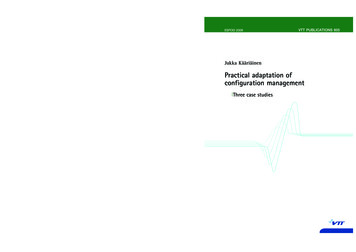
Transcription
ESPOO 2006Turunen, Erja. Diagnostic tools for HVOF process optimization. 2005. 66 p. app. 92 p.584Measures for improving quality and shape stability of sawn softwood timber duringdrying and under service conditions. Best Practice Manual to improve straightness ofsawn timber. Edited by Veikko Tarvainen. 2005. 149 p.585Hyötyläinen, Raimo. Practical interests in theoretical consideration. Constructive methodsin the study of the implementation of information systems. 2005. 159 p.586Koivisto, Tapio. Developing strategic innovation capability of enterprises. Theoretical andmethodological outlines of intervention. 2005. 120 p.587Ajanko, Sirke, Moilanen, Antero & Juvonen, Juhani. Kierrätyspolttoaineiden laadunvalvonta. 2005. 59 s.588Ebersberger, Bernd. The Impact of Public R&D Funding. 2005. 199 p. app. 12 p.589Kutinlahti, Pirjo. Universities approaching market. Intertwining scientific and entrepreneurial goals. 2005. 187 p. app. 4 p.590Jantunen, Erkki. Indirect multisignal monitoring and diagnosis of drill wear. 2005. 80 p. app. 110 p.591Rauste, Yrjö. Techniques for wide-area mapping of forest biomass using radar data. 2005.103 p. app. 77 p.592Safety and reliability. Technology theme – Final report. Ed. by Veikko Rouhiainen. 2006.142 p. app. 27 p.593Oedewald, Pia & Reiman, Teemu. Turvallisuuskriittisten organisaatioiden toiminnanerityispiirteet. 2006. 108 s. liitt. 10 s.594Lyly, Marika. Added ß-glucan as a source of fibre for consumers. 2006. 96 p. app. 70 p.595Hänninen, Saara & Rytkönen, Jorma. Transportation of liquid bulk chemicals by tankersin the Baltic Sea. 2006. 121 p. app. 30 p.596Vähä-Heikkilä, Tauno. MEMS tuning and matching circuits, and millimeter waveon-wafer measurements. 2006. 86 p. app. 82 p.597Lallukka, Sami & Raatikainen, Pertti. Passive Optical Networks. Transport concepts. 2006.123 p.598Lyyränen, Jussi. Particle formation, deposition, and particle induced corrosion in largescale medium-speed diesel engines. 2006. 72 p. app. 123 p.600Kontkanen, Hanna. Novel steryl esterases as biotechnological tools. 2006. 100 p. app. 54 p.601Askolin, Sanna. Characterization of the Trichoderma reesei hydrophobins HFBI and HFBII.2006. 99 p. app. 38 p.602Rosqvist, Tony, Tuominen, Risto & Sarsama, Janne. Huoltovarmuuden turvaamiseentähtäävä logistisen järjestelmän riskianalyysimenetelmä. 2006. 68 s. liitt. 20 s.605Kääriäinen, Jukka. Practical adaptation of configuration management. Three case studies.2006. 71 p. app. 48 p.Denna publikation säljs avThis publication is available fromVTTPL 100002044 VTTPuh. 020 722 4404Faksi 020 722 4374VTTPB 100002044 VTTTel. 020 722 4404Fax 020 722 4374VTTP.O. Box 1000FI-02044 VTT, FinlandPhone internat. 358 20 722 4404Fax 358 20 722 4374ISBN 951–38–6842–7 (soft back ed.)ISSN 1235–0621 (soft back ed.)ISBN 951–38–6843–5 (URL: http://www.vtt.fi/inf/pdf/)ISSN 1455–0849 (URL: http://www.vtt.fi/inf/pdf/)Jukka KääriäinenTätä julkaisua myyPractical adaptation of configuration management583VTT PUBLICATIONS 605VTT PUBLICATIONSVTT PUBLICATIONS 605Jukka KääriäinenPractical adaptation ofconfiguration managementThree case studies
VTT PUBLICATIONS 605Practical adaptation ofconfiguration managementThree case studiesJukka KääriäinenVTT
ISBN 951–38–6842–7 (soft back ed.)ISSN 1235–0621 (soft back ed.)ISBN 951–38–6843–5 (URL: http://www.vtt.fi/publications/index.jsp)ISSN 1455–0849 (URL: http://www.vtt.fi/publications/index.jsp)Copyright VTT Technical Research Centre of Finland 2006JULKAISIJA – UTGIVARE – PUBLISHERVTT, Vuorimiehentie 5, PL 2000, 02044 VTTpuh. vaihde 020 722 111, faksi 020 722 4374VTT, Bergsmansvägen 5, PB 2000, 02044 VTTtel. växel 020 722 111, fax 020 722 4374VTT Technical Research Centre of FinlandVuorimiehentie 5, P.O.Box 2000, FI–02044 VTT, Finlandphone internat. 358 20 722 111, fax 358 20 722 4374VTT, Kaitoväylä 1, PL 1100, 90571 OULUpuh. vaihde 020 722 111, faksi 020 722 2320VTT, Kaitoväylä 1, PB 1100, 90571 ULEÅBORGtel. växel 020 722 111, fax 020 722 2320VTT Technical Research Centre of FinlandKaitoväylä 1, P.O. Box 1100, FI-90571 OULU, Finlandphone internat. 358 20 722 111, fax 358 20 722 2320Technical editing Maini ManninenOtamedia Oy, Espoo 2006
Kääriäinen, Jukka. Practical adaptation of configuration management. Three case studies. Espoo2006. VTT Publications 605. 71 p. app. 48 p.Keywordssoftware engineering, software configuration management, configurationmanagement, embedded systems, agile methodsAbstractThis research studies the adaptation of configuration management. Configurationmanagement (CM) is a support process for product development and it operatesin the context of the development project. Several factors, such as the size of theproject, distribution, development disciplines, etc. affect the project’s CMsolution. Nowadays, CM practices inside a project have become an industrial defacto standard, but the complexity emerges from the modern operationalenvironment of product development. Globalisation, outsourcing, productvariation and the amount of SW in modern products have characterized themodern product development. This trend has also affected the CM practices,which need to face these new challenges.This study defines the initial framework of factors that affect the CM solution.These factors represent the project characteristics that the CM adaptation needsto solve when planning the CM solution for a project. Even though separatefactors can be identified, they coexist and therefore the planning of CM has totake these factors into account singly and together.The framework of factors has been used to characterise three CM adaptationcase studies. The case studies represent the two ends of the project types. Case 1represents a large multisite development project, while cases 2 and 3 representsmall SW development projects. The CM practices are considered based onfactors in each case and the results are discussed. Furthermore, a cross-caseanalysis has been carried out to detect and discuss similarities and differencesbetween the cases.The results indicate that the plan-based CM worked well and providedmechanisms for identifying CM solutions that suited the project context despite3
of the project size, although the formality and complexity of the CM solutionsvaried. Good communication between the product development teams as early asduring the CM planning phase was found essential to ensure consistent CMpractices.The study also revealed that inside a project, the CM practices are usually fairlywell realised, but the complexity and challenges of CM come from the size ofthe project (large), work distribution (project hierarchy, multisite development,dependence on third party software) and development disciplines (HW/SW).Especially, the management of interfaces was found crucial in complexdevelopment environment. Without strict practices unmanaged interfaces cancause difficult problems in the integration phase.4
PrefaceThis research has been carried out in VTT during the years 2002–2004. Thefoundation for the research was created in year 2002 in VTT’s strategic researchprogramme called UUTE (New software development technologies). The caseshave been documented in “Agile software technologies” -project and ITEAproject called MOOSE (Software Engineering MethOdOlogieS for EmbeddedSystems) during 2002–2004. This thesis was composed in ITEA-projects calledAGILE (Agile Software Development of Embedded Systems) and MERLIN(Embedded Systems Engineering in Collaboration) during the years 2005–2006.The work has been originally published as a licentiate thesis at the University ofOulu.I would like to give my thanks to the following persons that have made thisthesis possible. Professor Samuli Saukkonen has been the advisor of mylicentiate studies. Professor Oddur Benediktsson and Dr. Jorma Taramaa havebeen the reviewers of this thesis. They provided valuable comments thatimproved the quality of this thesis. Professor Pekka Abrahamsson providedvaluable comments and guidance throughout the research and writing process.Furthermore, I would like to give my gratitude to my family for all support andunderstanding during my studies.Oulu, May 2006Jukka Kääriäinen5
ContentsAbstract. 3Preface . 5List of original publications . 8List of acronyms . 91. Introduction. 101.1 Scope of the Research and the Research Problem. 121.2 Structure of the Research. 121.3 Research Methods . 132. Configuration Management . 152.1 Overview . 152.2 Concepts . 162.3 The Principal Elements. 192.3.1 Configuration Management Planning . 202.3.2 Configuration Identification. 222.3.3 Configuration Control . 232.3.4 Configuration Status Accounting . 252.3.5 Configuration Auditing . 262.4 Configuration Management on System Life Cycle . 272.5 Tools. 282.6 Summary . 303. Adapting Configuration Management in Practice . 313.1 Factors Affecting the Configuration Management Solution . 313.1.1 Size of the Project . 313.1.2 Product Type . 313.1.3 Project Hierarchy (Distribution). 323.1.4 Multisite Development. 323.1.5 Development Disciplines . 333.1.6 Development Models . 343.1.7 Dependence on Third Party Software . 343.1.8 Maintenance and Multivariants. 356
3.23.33.1.9 Item Types. 353.1.10 Management Constraints on the CM Plan. 36Framework of Factors. 36Summary . 384. Empirical Evaluation of Configuration Management Adaptation . 394.1 Case Study Characterisation. 394.1.1 Case 1 . 404.1.2 Case 2 . 404.1.3 Case 3 . 414.2 Results . 424.2.1 Case 1 . 424.2.2 Case 2 . 474.2.3 Case 3 . 494.2.4 Cross-case Analysis . 525. Introduction to the Papers . 575.1 Paper I: Configuration Management Support for the Development ofan Embedded system: Experiences in the Telecommunication Industry . 575.2 Paper II: Improving Software Configuration Management forExtreme Programming: a Controlled Case Study . 585.3 Paper III: Supporting Requirements Engineering in ExtremeProgramming: Managing User Stories . 585.4 Paper IV: Improving Requirements Management in ExtremeProgramming with Tool Support – an Improvement Attempt thatFailed. 596. Conclusions and Future Research Needs. 606.1 Evaluation of Results. 606.2 Answers to the Research Questions. 646.3 Future Research Needs . 67References. 68Appendices:Papers I–IV7
List of original publicationsThe research includes the following original publications:IKääriäinen, J. Taramaa, J. & Alenius, J. 2004. Configurationmanagement support for the development of an embedded system:experiences in the telecommunication industry. Tools and methods ofcompetitive engineering. Vol. 2. Millpress. The Fifth InternationalSymposium on Tools and Methods of Competitive Engineering(TMCE 2004). Lausanne, CH, 13–7 April 2004. Pp. 605–616.IIKoskela, J., Kääriäinen, J. & Takalo, J. 2003. Improving softwareconfiguration management for extreme programming: a controlled casestudy. EuroSPI 2003 Proceedings. Verlag der technischen UniversitätGraz, European Software Process Improvement, EuroSPI'2003. Graz,Austria, 10–12 Dec. 2003.IIIKääriäinen, J., Koskela, J., Takalo, J., Abrahamsson, P. &Kolehmainen, K. 2003. Supporting requirements engineering inextreme programming: managing user stories. Proceedings of theICSSEA 2003, 16th International Conference, Software SystemsEngineering and their Applications, Vol. 4. Paris, FR, 2–4 Dec. 2003,ICSSEA.IVKääriäinen, J. Koskela, J., Abrahamsson, P. & Takalo, J. 2004.Improving requirements management in extreme programming withtool support – an improvement attempt that failed. 30th EuromicroConference, EUROMICRO 2004, Rennes, 31 Aug.–3 Sept. 2004.IEEE Computer Society. Pp. 342–351.8
List of acronymsASICApplication Specific Integrated CircuitCCBChange Control BoardCMConfiguration ManagementCMOConfiguration Management OfficerCVSConcurrent Versions SystemDMDocument ManagementDSPDigital Signal ProcessingERPEnterprise Resource PlanningFCAFunctional Configuration AuditFPGAField Programmable Gate ArrayHWHardwareO&MOperation and MaintenancePCAPhysical Configuration AuditPDMProduct Data ManagementPLMProduct Lifecycle ManagementRMRequirements ManagementSCMSoftware Configuration ManagementSTDState Transition DiagramSWSoftwareVTTTechnical Research Centre of FinlandXPeXtreme Programming9
1. IntroductionThe use of software has increased in many different product types. Crnkovic etal. (2003) present that in 1990 the development costs of software (SW) were onethird of the total development costs of industrial robots while now it is twothirds. ITEA (2005) presents that investments for SW research and developmentwill increase dramatically in the near future (Figure 1).Figure 1. Forecast for the worldwide growth of R&D investment (ITEA 2005).The ability to produce quality products on time and at competitive costs iscrucial for any industrial organisation. Nowadays, also the needs of thecustomers have diverged. The customer specific product variation is oftenimplemented using SW rather than hardware (HW) and these customer specificversions of the products need to be maintained.The discipline that keeps the evolving product under control is calledConfiguration Management (CM). It is a well-known concept in softwareengineering and it has been widely discussed in literature and articles (forexample in Moreira (2004), Jonassen Hass (2003), Leon (2000), Estublier(2000), Dart (1996), Buckley (1996), Berlack (1992), Bersoff et al. (1980),10
ISO/IEC 10007 (1995), ISO/IEC 12207 (1995), IEEE Std-828 (1998) and IEEEStd-1042 (1987)). Configuration management has been identified as an essentialelement in increasing product quality, development efficiency and enterpriseprofitability (Schamp & Owens 1997).Practical CM solutions need to be planned in the context of a productdevelopment project. Factors, such as the size and the type of the product beingdeveloped, size of the project, project distribution, etc. shape the CM practicesof the project. Under the different factors, CM needs to address variouschallenges. For example, in a multisite development environment, workallocation and information sharing are crucial in controlling the developmentactivities. In literature, the concept of configuration management has beenexamined in various contexts, such as: Multitechnology products (SW/HW) e.g. in Taramaa (1998), Lyon(1999), Buckley (1996) and Crnkovic et al. (2003). Agile development e.g. in Christensen (2001), Paulk (2001), JonassenHass (2003) and Berczuk and Appelton (2003). Multisite development e.g. in Ebert and De Neve (2001), Battin et al.(2001), Rahikkala (2000) and Jonassen Hass (2003).SW development of significant products is a very complex undertaking. Thecomplexity of CM is a result of its context dependent nature. CM is a supportprocess that is adapted into the product development environment. Although thebasic elements of CM are the same, the interaction of several factors cause thatthe practical implementation of CM varies. We are also living in a changingworld requiring more flexibility and abilities to adapt to new developmentapproaches to survive in the global competition. One example of this is the shiftfrom the traditional in-house product development to the collaborativedevelopment environment with the use of subcontracting and SW components.The changing development environment demands that CM face these newrequirements whenever they emerge.11
1.1 Scope of the Research and the Research ProblemThis research focuses on the context dependent nature of CM. It considers theplanning process and activities of CM and examines what kind of factorsinfluence the CM solutions in the SW development. As SW is an important partof any modern electronics product, the connections to the HW development willalso be considered.The goal of the research is to gain a better understanding of the factors thatshape the CM solutions of an organisation. The research will identify the initialset of factors forming a basis for further research. These factors will be used toanalyse case studies that are from the fields of embedded system development,information system development and mobile SW development.Based on the discussion above, we state the research questions as follows: What is the basic mechanism for adapting configuration management? What kind of factors influence the configuration management solutions? How these factors affect the CM planning and the practical CM solutions?1.2 Structure of the ResearchSection 1 introduces the structure of the study and discusses the researchproblem and research methods used in this study.Section 2 presents an overview and concepts of configuration management.Then, it introduces the principal elements of CM, including planning,identification, control, status accounting and auditing. Furthermore, it alsoconsiders the role of CM in the system life cycle and the automation of CM.Section 3 presents a framework that describes the factors that affect the CMprocess instantiation. This framework is used to analyse the CM solutions inthree case studies in section 4. First, section 4 introduces the cases based on thefactors of the framework. Next the section presents how these factors map with12
CM solutions in the cases. Finally, the section presents a cross-case analysisover the cases and discusses the similarities and differences of the cases.Section 5 introduces papers that have been included into this research. Section 6discusses the results gained from the analysis, answers the research questionsand states future research needs.1.3 Research MethodsThe selection and adaptation of the CM solution for a project is a complex whereseveral factors affect the selected solution. The concepts and factors related tothe adaptation of CM were considered based on literature study. This studyprovides a conceptual basis for the research and resulted in an overall frameworkof the factors that affect the adaptation of CM. These factors reveal the contextdependent nature of CM.The adaptation of CM was studied empirically through three case studies asfollows (see section 5 for more information on the papers behind the cases): Case 1 considers observations while adapting CM for a projectdeveloping digital signal processing (DSP) SW and HW related DSP SWin a distributed development environment containing HW/SW codesign. Case 2 considers observations while adapting CM for a project (namedeXpert) that used agile development principles for producing a SWsystem for managing the research data and documents. Case 3 considers observations while adapting CM and improving RMfor a project (named zOmbie) that used agile development principlesfor developing a financial sector mobile SW.Yin (1994) defines a case study a method that examines a phenomenon within itsreal-life context. This method is suitable because it tries to produce intensive anddetailed information on the context-dependent cases. The method also providesroom for the diversity and complexity of a phenomenon. This is essential whenpractical solutions are the results of the interaction of many factors. Actionresearch (e.g. in Hult and Lennung (1980) and Susman and Evered (1978)) is a13
method that is typically used by practitioners who analyze the data to improvetheir own practice. It is used to improve the quality of an organization and itsperformance in the active interaction of research and practice. It aims at betterunderstanding of a theory while improving the state of the practice in anorganisation.The context of each case (e.g. size of the project, distribution, methods used)was introduced using the framework defined in this research. Based on Yin(1994), the study can be based on one or several cases. In this research, first theconfiguration management solutions in each case were introduced and discussed.Then, these three case studies were examined using a cross case analysis todiscuss similarities and differences between the cases.14
2. Configuration ManagementThe purpose of this section is to provide an introduction for configurationmanagement. The section introduces the concepts, activities and tool issues ofconfiguration management.2.1 OverviewThe roots of CM are in the defence industry environment as a discipline toresolve problems with poor product quality, parts ordering, and parts not fitting,which were leading to high cost overruns (Berlack 1992). Control andcommunication problems lead to the first standard for CM, called AFSCM 375-1(Berlack 1992, Leon 2000). At the beginning, the focus was on the CM ofhardware oriented products. The need for the management of software artefactsbecame topical as software engineering industry emerged. According toEstublier et al. (2005) software CM (SCM) emerged as a separate discipline inthe 1970s, with the advent of tools such as SCCS, RCS and Make. Thetraditional products that were composed based on mechanical and electronicscomponents included more and more software. Nowadays, also softwaredevelopment as an engineering activity is more complex. It ties up moredevelopers from different cultural backgrounds, as globalisation removesnational borders. Furthermore, the news that a product is bad and has a bug canspread very fast (e.g. newsgroups), which forces a company to provide the fixesand patches very quickly to save face and prevent its market share fromdropping (Leon 2000).The term configuration management is originally directed for the managementof hardware oriented systems while the term software configurationmanagement can be defined as “configuration management tailored to systems,or portions of systems, that are comprised predominantly of software” (Bersoffet al. 1980). Software configuration management and hardware configurationmanagement are quite similar. They both aim at the same objectives. However,Tichy (1988) presents that SCM differs from CM in the two ways: software iseasier to change and SCM is easier to automate.15
The evolution of software configuration management has been driven by theresearch community (Crnkovic et al. 2001). It has been identified as a matureand one of the most successful branches of software engineering (Estublier et al.2002). In this study, CM is treated especially from the point of view of softwaredevelopment.2.2 ConceptsThis section explains the key concepts that are used in the CM literature and thatwill be used in the following sections of the study.Configuration management is defined by the IEEE Std 610.12 (1990) as a disciplineapplying technical and administrative direction and surveillance to identify anddocument the functional and physical characteristics of a configuration item, controlchanges to those characteristics, record and report change processing andimplementation status, and verify compliance with specified requirements. In short,CM is a discipline controlling the consistency between the parts of an entire system.Standards, such as ISO/IEC 10007 (1995) and ISO/IEC 12207 (1995) introduce it asa support process for product development.Configuration item is treated as a single entity in the CM process. Item types thatare subject to CM may be, for instance, in-house developed or purchased from avendor (Buckley 1996). Further, these items can be deliverable items under thecontract or used to produce the deliverable item (Buckley 1996). The selectionof configuration items is important because different types of configurationitems have different needs for control. Buckley (1996) divides the software itemselection into two parts: the selection of software categories (e.g. productsoftware, vendor-provided software and test software) and the identification ofitem types in each category (e.g. source files, documents and executables). Therole of the item selection is to determine these classes. A software category thatis often forgotten is a vendor-provided software that needs special attention, forinstance, from the change management point of view. IEEE Std-828 (1998)highlights the importance of two software categories. First, subcontractor/vendorcontrol needs special attention because of the organisational and legalrelationships. According to the standard, there has to be practices for how thesoftware will be received, tested, and placed under CM; how changes to the16
supplier’s software are to be processed; and whether and how the supplier willparticipate in the project’s change management process. Second, the externalitems to which the project software interfaces need to be identified and managed.Term version is used to describe the evolution of the item (item’s versions) and aterm product variant refers to the development of families of related products.Check-out is the process of copying the item from the CM tool to the user’sworking area for modification. On the other hand, check-in is the process ofmoving the configuration items into a CM tool. This operation produces a newversion of the item. The version control mechanisms can be divided into:pessimistic and optimistic version control (Mens 2002): With pessimistic version control, all participants work on the same set ofsoftware artefacts and parallel editing of the same artefact is preventedby locking (when checking out an artefact for modifications). With optimistic version control, each developer can work on a personalcopy of a software artefact (multiple check-outs). This requiresmechanisms (merge) to integrate the personal copies when checking inthe code back into the version control.Basically, versions are described as the linear set of developed items (v1 v2 v3). Linear development is not always possible and thus we need the conceptbranch (Leon 2000). Branches may be needed for the bug-fixing of the oldversion of the product or for the parallel development of a single file. Accordingto Leon (2000), branches are deviations from the main development line for theitem and they can also be extended from the existing branch. The term mergeexpresses the incorporation of parallel changes with the main development line.A software development process transforms the description of the SW systemfrom abstract to concrete, typically from requirements specification via design toimplementation. The different configurations (a collection of configurationitems) need to be managed during the development process. However, all theversions are not equally important. The configuration of the software at adiscrete point in time is known as a baseline (Leon 2000). The baseline is thecornerstone o
Kääriäinen, Jukka. Practical adaptation of configuration management. Three case studies. Espoo 2006. VTT Publications 605. 71 p. app. 48 p. Keywords software engineering, software configuration management, configuration management, embedded systems, agile methods Abstract This research studies the adaptation of configuration management .
